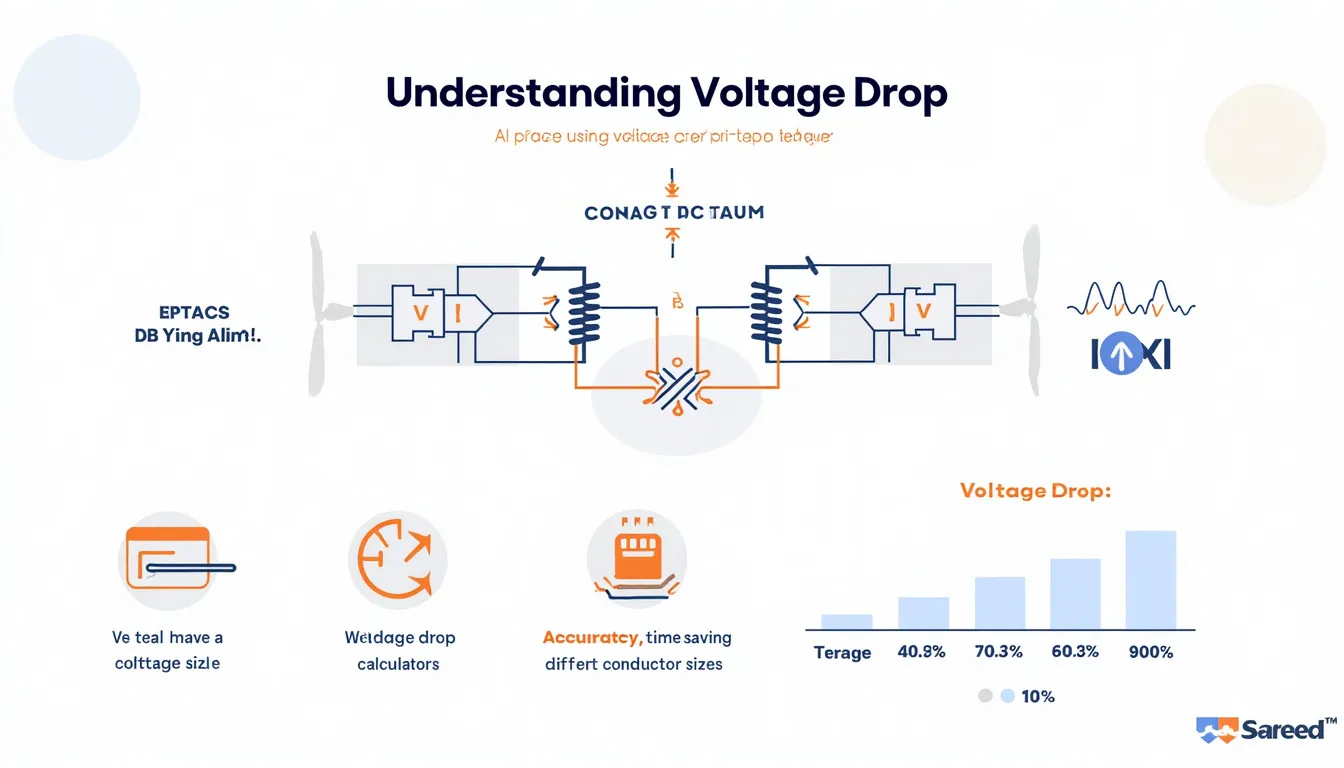Voltage Drop Calculator
Is this tool helpful?
How to Use the Voltage Drop Calculator Effectively
Our Voltage Drop Calculator is designed to help electricians, engineers, and DIY enthusiasts accurately determine the voltage drop in electrical circuits. Follow these steps to use the calculator effectively:
- Select Measurement System: Choose between Imperial (feet, AWG) or Metric (meters, mm²) units.
- Enter Conductor Length: Input the length of the conductor in feet or meters (e.g., 150 feet).
- Specify Load Current: Enter the current flowing through the circuit in amperes (e.g., 80 A).
- Input Supply Voltage: Provide the voltage at the source in volts (e.g., 240 V).
- Choose Conductor Material: Select either Copper or Aluminum.
- Select Conductor Size: Choose the appropriate AWG size or mm² from the dropdown menu (e.g., 4 AWG).
- Specify Circuit Type: Select either Single-phase or Three-phase.
- Calculate: Click the “Calculate Voltage Drop” button to see the results.
The calculator will display the voltage drop, voltage drop percentage, voltage at the load, and provide recommendations based on the results.
Understanding Voltage Drop: Definition, Purpose, and Benefits
Voltage drop refers to the decrease in electrical potential along a conductor carrying current. It’s a crucial concept in electrical engineering and installation, affecting the performance and safety of electrical systems.
Purpose of Calculating Voltage Drop
The primary purposes of calculating voltage drop include:
- Ensuring proper operation of electrical equipment
- Maintaining system efficiency
- Complying with electrical codes and standards
- Preventing overheating and fire hazards
- Optimizing conductor size selection
Benefits of Using a Voltage Drop Calculator
Utilizing a voltage drop calculator offers numerous advantages:
- Accuracy: Eliminates manual calculation errors
- Time-saving: Quickly determines voltage drop for various scenarios
- Cost-effective: Helps in selecting the most economical conductor size
- Compliance: Ensures adherence to electrical standards
- Flexibility: Allows for easy comparison of different materials and sizes
- Improved system design: Facilitates better planning of electrical installations
The Science Behind Voltage Drop Calculations
Understanding the underlying principles and formulas used in voltage drop calculations is essential for electrical professionals and enthusiasts alike.
Voltage Drop Formula for Single-Phase Circuits
For single-phase AC or DC circuits, the voltage drop is calculated using the following formula:
$$V_{drop} = \frac{2 \times K \times I \times L}{A}$$Where:
- Vdrop = Voltage drop (volts)
- K = Resistivity constant of the conductor material (ohm·cmil/ft)
- I = Current (amperes)
- L = One-way length of the conductor (feet)
- A = Cross-sectional area of the conductor (circular mils)
Voltage Drop Formula for Three-Phase Circuits
For three-phase AC circuits, the formula is slightly modified:
$$V_{drop} = \frac{\sqrt{3} \times K \times I \times L}{A}$$Resistivity Constants (K) for Common Conductor Materials
The resistivity constant K varies based on the conductor material:
- Copper at 75°C: K = 12.9 ohm·cmil/ft
- Aluminum at 75°C: K = 21.2 ohm·cmil/ft
Addressing User Needs and Solving Specific Problems
Our Voltage Drop Calculator addresses several key user needs and solves specific problems encountered in electrical design and installation:
1. Conductor Size Selection
Problem: Determining the appropriate conductor size to minimize voltage drop while balancing cost considerations.
Solution: The calculator allows users to input different conductor sizes and instantly see the resulting voltage drop. This feature enables quick comparison and optimal size selection.
2. Compliance with Electrical Codes
Problem: Ensuring that voltage drop remains within acceptable limits as specified by electrical codes (typically 3% for branch circuits and 5% for feeders).
Solution: The calculator provides the voltage drop percentage and offers recommendations if the calculated value exceeds standard limits.
3. System Efficiency Analysis
Problem: Assessing the impact of voltage drop on overall system efficiency.
Solution: By calculating the voltage at the load, users can determine if equipment will operate within its specified voltage range, ensuring optimal performance.
4. Material Cost Optimization
Problem: Balancing material costs with electrical performance requirements.
Solution: The ability to switch between copper and aluminum conductors allows users to compare different materials and their impact on voltage drop, facilitating cost-effective decisions.
Practical Applications and Examples
Let’s explore some practical applications of the Voltage Drop Calculator through examples:
Example 1: Residential Wiring
Scenario: Installing a 240V, 30A electric dryer circuit in a home.
Inputs:
- Conductor Length: 75 feet
- Load Current: 30 A
- Supply Voltage: 240 V
- Material: Copper
- Conductor Size: 10 AWG
- Circuit Type: Single-phase
Results:
- Voltage Drop: 4.65 V
- Voltage Drop Percentage: 1.94%
- Voltage at Load: 235.35 V
Interpretation: The voltage drop is within acceptable limits (<3%), and the 10 AWG conductor is suitable for this application.
Example 2: Industrial Motor Circuit
Scenario: Powering a 460V, 50HP three-phase motor in a factory.
Inputs:
- Conductor Length: 200 feet
- Load Current: 65 A
- Supply Voltage: 460 V
- Material: Aluminum
- Conductor Size: 2 AWG
- Circuit Type: Three-phase
Results:
- Voltage Drop: 9.82 V
- Voltage Drop Percentage: 2.13%
- Voltage at Load: 450.18 V
Interpretation: The voltage drop is acceptable for a feeder circuit (<5%). The 2 AWG aluminum conductor is appropriate for this motor circuit.
Example 3: Solar Panel Array
Scenario: Connecting a solar panel array to an inverter in a large-scale solar farm.
Inputs:
- Conductor Length: 500 feet
- Load Current: 100 A
- Supply Voltage: 600 V (DC)
- Material: Copper
- Conductor Size: 1/0 AWG
- Circuit Type: Single-phase (DC)
Results:
- Voltage Drop: 24.43 V
- Voltage Drop Percentage: 4.07%
- Voltage at Load: 575.57 V
Interpretation: The voltage drop exceeds 3% but is still within 5%. Depending on specific requirements, a larger conductor size (e.g., 2/0 AWG) might be considered to reduce voltage drop further.
Advanced Features and Considerations
Temperature Correction
While our calculator uses standard resistivity values at 75°C, actual conductor temperatures can vary. For more precise calculations in extreme conditions, consider applying temperature correction factors.
Voltage Drop in Parallel Conductors
When using multiple conductors in parallel, the effective cross-sectional area increases, reducing voltage drop. Adjust the calculator inputs accordingly by entering the total effective area.
Considering Reactive Components
In AC circuits, especially over long distances or with large currents, the reactive component of voltage drop may become significant. Advanced calculations might be necessary for high-precision requirements in such cases.
Frequently Asked Questions (FAQ)
Q1: Why is voltage drop important?
A1: Voltage drop is crucial because it affects the performance and safety of electrical systems. Excessive voltage drop can lead to equipment malfunction, overheating, and increased energy consumption.
Q2: How often should I calculate voltage drop?
A2: Voltage drop should be calculated for every new electrical installation and when making significant changes to existing systems. It’s also useful when troubleshooting performance issues.
Q3: Can I use this calculator for both AC and DC systems?
A3: Yes, the calculator can be used for both AC and DC systems. The formulas apply to both, with slight modifications for three-phase AC systems.
Q4: What’s the difference between voltage drop and voltage loss?
A4: These terms are often used interchangeably. Voltage drop refers to the decrease in voltage along a conductor, while voltage loss might be used more broadly to include other sources of voltage reduction in a system.
Q5: How does conductor material affect voltage drop?
A5: Different materials have different resistivity values. Copper generally has lower resistivity than aluminum, resulting in less voltage drop for the same size and length of conductor.
Q6: Can voltage drop be eliminated completely?
A6: While voltage drop cannot be eliminated entirely, it can be minimized by using larger conductors, shorter cable runs, or higher supply voltages. The goal is to keep it within acceptable limits.
Q7: How does temperature affect voltage drop?
A7: Higher temperatures increase conductor resistance, leading to greater voltage drop. Our calculator uses standard values at 75°C, but extreme temperatures may require additional considerations.
Q8: What’s the relationship between voltage drop and power loss?
A8: Voltage drop is directly related to power loss in conductors. The power lost due to voltage drop is calculated as P = I² × R, where I is the current and R is the resistance of the conductor.
Q9: How does voltage drop affect equipment performance?
A9: Excessive voltage drop can cause equipment to operate below its rated voltage, potentially leading to reduced efficiency, overheating, or premature failure.
Q10: Can I use this calculator for high-voltage transmission lines?
A10: While the basic principles apply, high-voltage transmission lines often require more complex calculations that consider additional factors such as capacitance and inductance.
Conclusion: Empowering Electrical Design with Precision
The Voltage Drop Calculator is an invaluable tool for anyone working with electrical systems, from DIY enthusiasts to professional engineers. By providing quick, accurate calculations, it enables users to make informed decisions about conductor sizing, material selection, and system design.
Remember that while this calculator offers a solid foundation for voltage drop analysis, complex or critical systems may require additional considerations and professional expertise. Always consult local electrical codes and standards when designing and implementing electrical systems.
By understanding and managing voltage drop effectively, we can create more efficient, safer, and more reliable electrical installations. Whether you’re wiring a home, designing an industrial power system, or planning a renewable energy project, the principles of voltage drop calculation are essential for success.
Important Disclaimer
The calculations, results, and content provided by our tools are not guaranteed to be accurate, complete, or reliable. Users are responsible for verifying and interpreting the results. Our content and tools may contain errors, biases, or inconsistencies. We reserve the right to save inputs and outputs from our tools for the purposes of error debugging, bias identification, and performance improvement. External companies providing AI models used in our tools may also save and process data in accordance with their own policies. By using our tools, you consent to this data collection and processing. We reserve the right to limit the usage of our tools based on current usability factors. By using our tools, you acknowledge that you have read, understood, and agreed to this disclaimer. You accept the inherent risks and limitations associated with the use of our tools and services.







